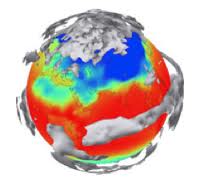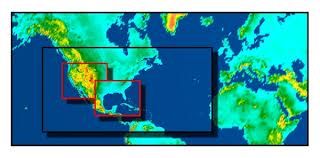
19 Apr EARTH MATTERS: WEATHER AND CLIMATE PREDICTIONS

Global Climate Model
I routinely hear the public at large interchange the terms “weather” and “climate” when discussing topics related to Earth’s atmosphere. Alas, this fundamental misinterpretation leads to a plethora of false ideas about climate change modeling.
In simple terms, weather is what you see outside your window at the moment; climate refers to the trend of weather over time.
In the last 20 years there have been impressive gains in evidence-based knowledge of climate science. Extensive studies of the chemical composition of the Earth’s atmosphere preserved in tree rings, layers of ice in glaciers, ocean sediments, coral reefs, and layers of sedimentary rocks have revealed 800,000 years of Earth’s atmospheric history. The facts indicate, without doubt, that global warming prior to 1750 was naturally induced by volcanic activity. However, the chemical composition of the atmosphere preserved in the core samples also confirms that climate change in the modern era has been induced by anthropogenic actions. Moreover, the intensive use of fossil fuels in the last century has caused global temperatures to rise 10X faster than the average rate of ice-age-recovery warming.
Nonetheless, our ability to produce accurate and reliable predictions of regional climate change and weather events remains insufficient for many societal needs. How many times have we planned to wax our skis for a deep powder day on the local ski hill based on information gained from meteorologist or weather graphs only to wake up in the morning to a disappointing dust on crust? According to the National Center for Atmospheric Research (NCAR), the days of unpredictability will soon be history as recent advances in computer modeling will produce far more accurate and reliable predictions of regional climate change and local weather events.

Regional Weather Model
Central to this effort, Senior Scientist James W. Hurrell and others at NCAR have developed advanced observing facilities, increasingly powerful supercomputing capabilities, and valuable research data sets to support a Nested Regional Climate Model (NRCM) that combines the NCAR Weather Research and Forecasting (WRF) model and the Community Climate System Model (CCSM). The strategic goal of NCAR involves using the NRCM to improve the fidelity of climate change and weather simulations for the intermountain west. Specifically, The NRCM approach entails improving the resolution of regional modeling of vertically staked horizontal rectangles from approximately 55 x 75 miles at mid-latitudes to about 2.5 miles or less in areas of particular interest.
As a result of greatly enhanced predictions and understanding of climate trends and weather phenomena, all sectors of society will be able to reduce risk, build resilience, and create new opportunities.
On top of that, skiers in Telluride will be able to sleep comfortably knowing the next day will include many face shots.


Sorry, the comment form is closed at this time.